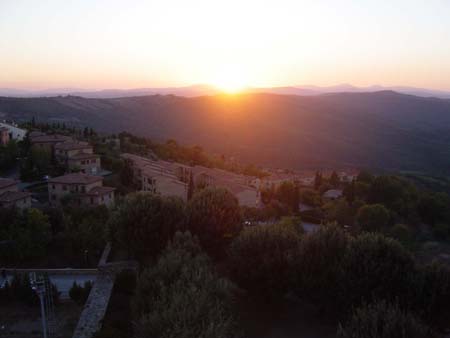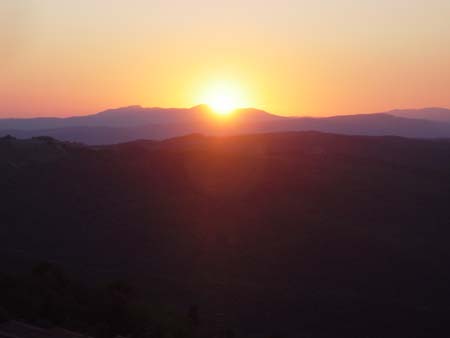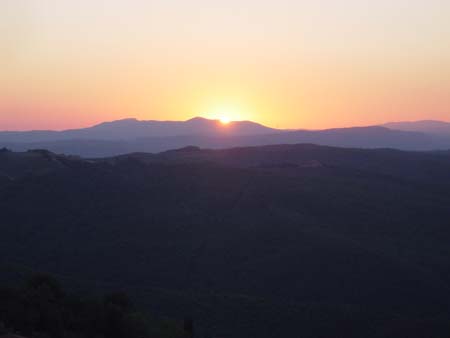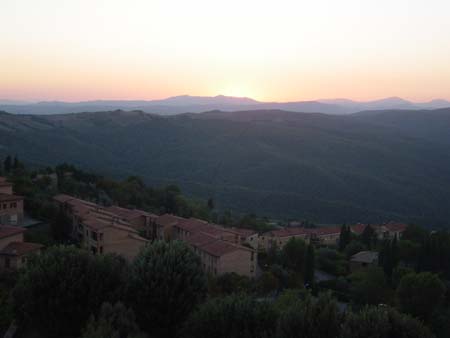Thursday, September 25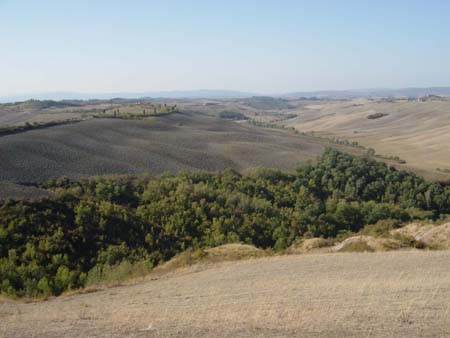
Steve: Today we spent a wonderful day with Roberta exploring the southern part of Tuscany. We have heard and read much about this area, but this was our first opportunity to spend time here. The weather was absolutely perfect, and we set out early in anticipation of a full day.
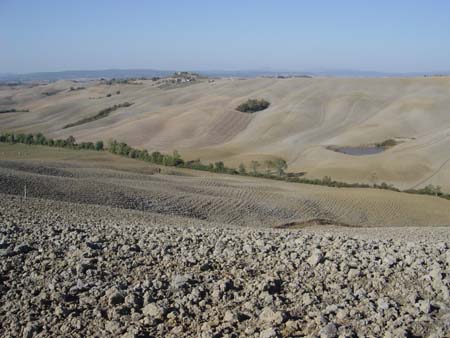
We got lost on the way to meet Roberta (one of the only times our GPS mapping
software has failed us), but this actually turned out to be a good thing.
We called Roberta's mobile phone and she directed us to take a road toward
Asciano - she assured us that we'd love the scenery on the way. She was right!
The road is called the "Clay Way", and is famous for its spectacular
scenery. The Clay Way cuts through miles of plowed fields displaying beautiful
shades of browns and reds, with 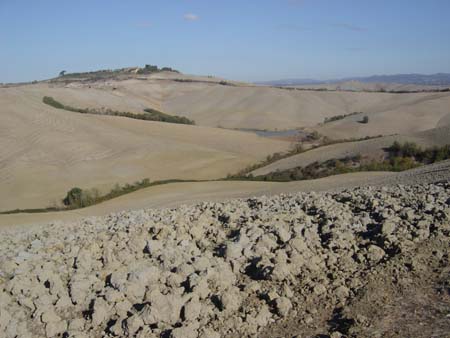 mountains
and hills all around. The variety of colors and textures is amazing - we've
never seen anything like it. These fields are used for planting a variety
of grains, but are plowed after the spring harvest and these colors are present
through the winter. We saw several farmers plowing today, and were able to
see how the color of the clay changes as its plowed. Although we took many
pictures, none were able to adequately capture the beauty of this very special
area. We hope to come back here to hike and explore this area some more -
it's very different from the landscape surrounding Ponte a Bozzone and the
Chianti region.
mountains
and hills all around. The variety of colors and textures is amazing - we've
never seen anything like it. These fields are used for planting a variety
of grains, but are plowed after the spring harvest and these colors are present
through the winter. We saw several farmers plowing today, and were able to
see how the color of the clay changes as its plowed. Although we took many
pictures, none were able to adequately capture the beauty of this very special
area. We hope to come back here to hike and explore this area some more -
it's very different from the landscape surrounding Ponte a Bozzone and the
Chianti region. 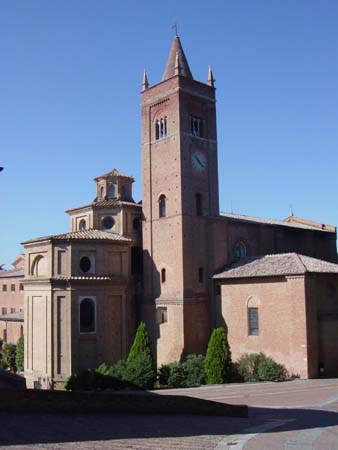
We arrived in Asciano and followed the road to our first stop - the Monte
Oliveto Maggiore abbey. This Benedictine abbey is set on a hill deep within
a cypress forest, and is extremely beautiful. Attached to the abbey is The
Great Cloister, containing 36 frescoes depicting the life of St. Benedict.
These frescoes line the walls surrounding a peaceful courtyard, and are well
known for their exceptional detail and color - they were painted by Signorelli
and Sodoma. Most of the frescoes we've seen have been in churches, and we
really enjoyed viewing these frescoes in such a different setting.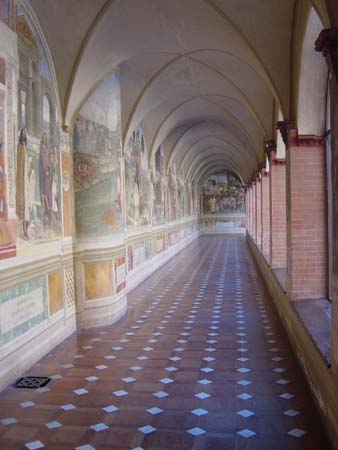 It was also interesting to walk through the abbey and see its library, the
monks' dining room and the pharmacy (several natural healing products are
sold on site).
It was also interesting to walk through the abbey and see its library, the
monks' dining room and the pharmacy (several natural healing products are
sold on site).
On the drive to Pienza, Roberta pointed out several stops along the road
where we could take pictures that duplicate several famous postcards from
Tuscany. One of these is a unique group of cypress trees that is very frequently
photographed. We did our best, but our pictures definitely don't due justice
to this place…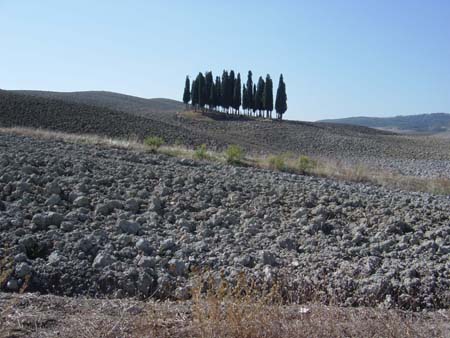
We arrived in Pienza, a small town that sits on a hill with sweeping views
of the surrounding countryside. Pienza is best known for its Renaissance architecture.
Pope Pius II was born here, and decided in the mid-15th century to totally
transform Pienza from a typical medieval village to a Renaissance style. The
Pope hired Bernardo Rossellino to be his architect, and 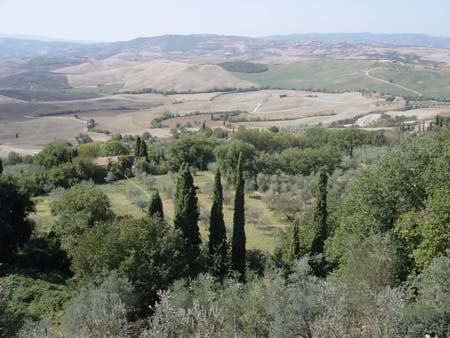 Pienza's
town square is well-known for its unique Renaissance design. Rossellino had
very little physical area to work with, so he designed the buildings to be
at precise angles to create a sense of space. Unfortunately, the Pope died
soon after the square was completed, so very little of Pienza ended up being
transformed.
Pienza's
town square is well-known for its unique Renaissance design. Rossellino had
very little physical area to work with, so he designed the buildings to be
at precise angles to create a sense of space. Unfortunately, the Pope died
soon after the square was completed, so very little of Pienza ended up being
transformed.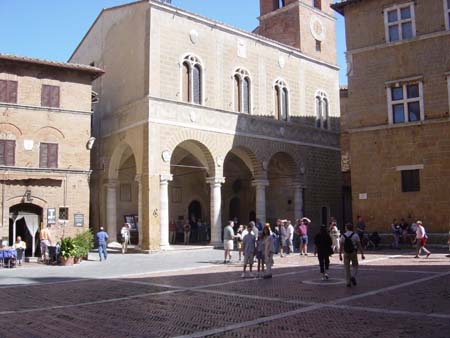
Pienza is famous for its Pecorino (sheep) cheese, and there are several wonderful
cheese shops along the main street. The smells inside these shops are great,
and they all offer free tastes. After trying several, we fortunately all agreed
on the one we liked best, and purchased a large chunk to take home. Before
leaving Pienza, we had a great lunch at Roberta's favorite spot - a restaurant
called La Bucca delle Fate. We all had homemade picci with tomato sauce -
it was wonderful! We learned in Florence that picci is purely a Siennese dish
- 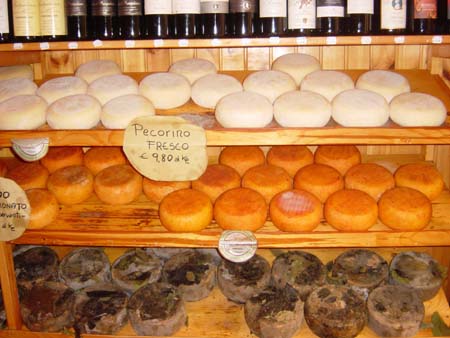 it's
not on menus anywhere in Florence, but is the primary pasta that we see in
towns around Siena. Perhaps this dates back to all the conflicts that have
occurred between Siena and Florence throughout the years…
it's
not on menus anywhere in Florence, but is the primary pasta that we see in
towns around Siena. Perhaps this dates back to all the conflicts that have
occurred between Siena and Florence throughout the years…
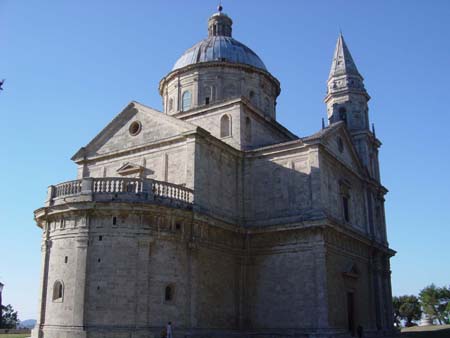 Next
we drove to Montelpulciano, one of the larger towns in Southern Tuscany. Montepluciano
sits high on a hill, and is well known for many of the great wines produced
here. We parked beside the hill, and decided to walk off our lunch by hiking
up the winding roads that lead into the town. Montelpulciano has several interesting
shops and cafes, and also several ancient wine cellars that are still used
today. Roberta took us to several of these cellars, and we enjoyed seeing
a variety of wines being aged in
Next
we drove to Montelpulciano, one of the larger towns in Southern Tuscany. Montepluciano
sits high on a hill, and is well known for many of the great wines produced
here. We parked beside the hill, and decided to walk off our lunch by hiking
up the winding roads that lead into the town. Montelpulciano has several interesting
shops and cafes, and also several ancient wine cellars that are still used
today. Roberta took us to several of these cellars, and we enjoyed seeing
a variety of wines being aged in 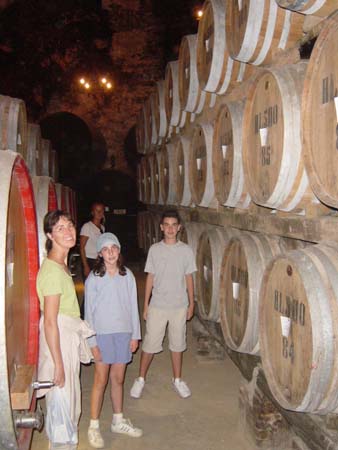 different
types of barrels. We had a great time tasting several wines with Roberta -
she laughed at us as we failed repeatedly to identify the correct smells present
in the various wines that we tasted (Katie swears that she smells raspberry
in every single wine!). Roberta also said that we
different
types of barrels. We had a great time tasting several wines with Roberta -
she laughed at us as we failed repeatedly to identify the correct smells present
in the various wines that we tasted (Katie swears that she smells raspberry
in every single wine!). Roberta also said that we 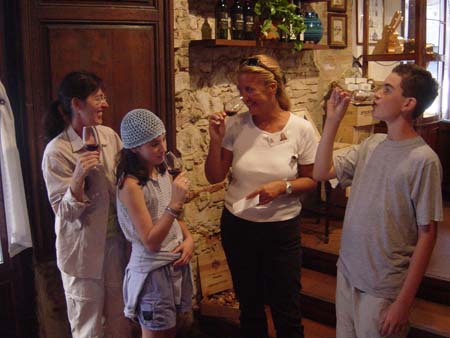 have
"typical American tastes" - we shy away from the complex wines that
she says are the true great wines of Italy, and tend to like the smoother,
simpler varieties. She had a good time poking fun at us! Roberta also created
several pages for us that cover the various characteristics of wines and also
describe how to mix specific foods and wines. We now have lots of homework!
have
"typical American tastes" - we shy away from the complex wines that
she says are the true great wines of Italy, and tend to like the smoother,
simpler varieties. She had a good time poking fun at us! Roberta also created
several pages for us that cover the various characteristics of wines and also
describe how to mix specific foods and wines. We now have lots of homework!
Our next stop was the old town of Bagno Vignoli. This is a tiny medieval
spa village with a town center that was built directly on top of a bubbling
hot water spring. The village basically consists of group of houses built
on a wall that surrounds the spring - we 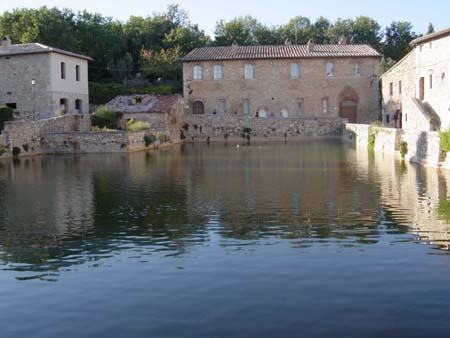 could
see the water bubbling in the center of the "town square." The spring
leads through a series of channels down to natural pools at the bottom of
a cliff. We had hoped to take a swim in the pools, but the day had cooled
off and so had the water. Instead, we soaked our feet in one of the hot water
streams and enjoyed the refreshing air and scenery.
could
see the water bubbling in the center of the "town square." The spring
leads through a series of channels down to natural pools at the bottom of
a cliff. We had hoped to take a swim in the pools, but the day had cooled
off and so had the water. Instead, we soaked our feet in one of the hot water
streams and enjoyed the refreshing air and scenery. 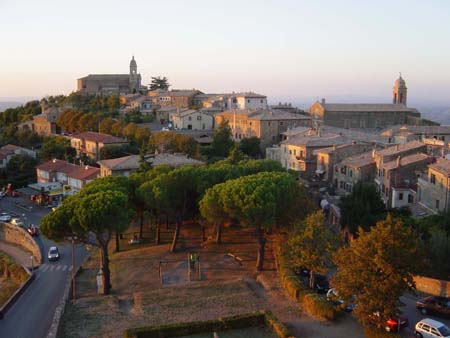
We saved Montalcino for last so that we could see the views in the late afternoon
light and catch the sunset from the top of the hill. Montalcino is famous
for its Brunello wines. Brunello is produced only in the small vineyards that
surround the town, and is considered to be one of the best wines in Italy.
We started by climbing to the top of Montalcino's fortress, which affords
great views in all directions. It was actually very 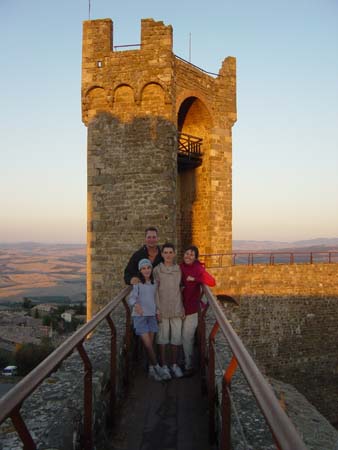 cool
and windy on top - quite a change from what we've become used to! We enjoyed
climbing each of the towers of the fortress, and stayed to watch a beautiful
sunset over the hills.
cool
and windy on top - quite a change from what we've become used to! We enjoyed
climbing each of the towers of the fortress, and stayed to watch a beautiful
sunset over the hills.
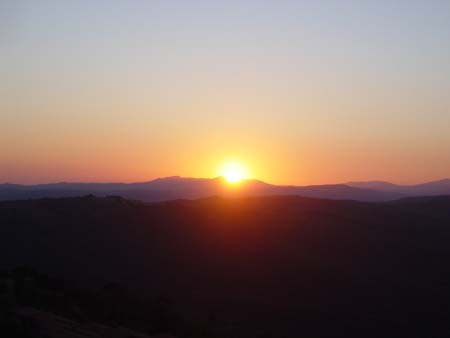
We walked into the town center, literally filled with Brunello wine stores.
There are ceramic tiles displayed in the town square, one for each year of
the Brunello harvest. Every year's harvest is given an official rating of
between one and five stars, and the tiles incorporate the rating for each
particular harvest into an artistic design (the one shown here is for 2000
and its 3-star rating). Roberta gave us a pamphlet that reviews every historical
year of the harvest and explains what weather-related phenomenon led to the
rating by year. 1997 was the best harvest that this area has had in the last
50 years - this was due to perfect weather that included a very dry September
and October which ripened the grapes thoroughly and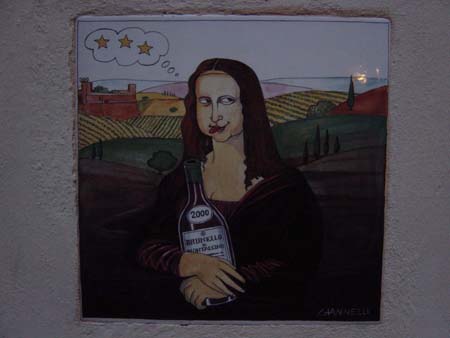 perfectly. This contrasts with years such as 1984 (one star) where constant
September rains rotted and ruined almost the entire harvest.
perfectly. This contrasts with years such as 1984 (one star) where constant
September rains rotted and ruined almost the entire harvest.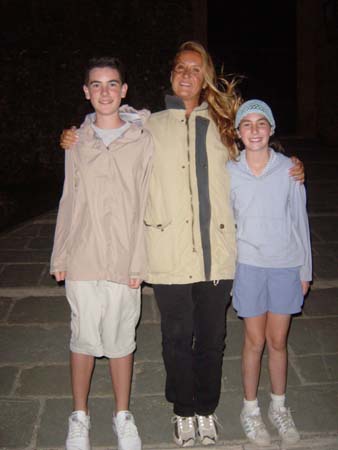
Finally, it was time to say goodbye to Roberta. We had a really wonderful day today, largely due to Roberta. It was funny to see how quickly David and Katie became comfortable with Roberta and began treating her as part of the family. Even though today was a very busy day, Katie's telltale comment this evening was that "this day was way too short." We will definitely keep in touch with Roberta, and promised that we'll return to spend time again with her again in this very special place.
Distance Walked: 5.84 miles
